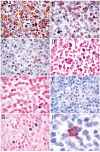Detection of human herpesvirus DNA in Kikuchi-Fujimoto disease and reactive lymphoid hyperplasia
- PMID: 18787614
- PMCID: PMC2480545
Detection of human herpesvirus DNA in Kikuchi-Fujimoto disease and reactive lymphoid hyperplasia
Abstract
Kikuchi-Fujimoto disease (KFD), or histiocytic necrotizing lymphadenitis, is a subacute inflammatory disorder most often seen in young women with clinicopathologic features suggestive of an infectious etiology. The most commonly suspected infectious agents in KFD are the human herpesviruses EBV, HHV6, HHV7 and HHV8. In order to identify herpesviruses in KFD, we have compared the frequency of detection of herpesvirus DNA with a recently developed real time PCR method, EBER in situ hybridization, and EBV latent membrane protein (LMP) immunostaining in 30 cases of KFD and 12 cases of reactive lymphoid hyperplasia (RLH). EBV DNA was commonly detected, while HSV2, CMV, HHV6, and HHV7 DNA were seldomly detected, and HSV1, VZV, and HHV8 DNA were not detected in KFD. EBV was also commonly detected in RLH. EBER-positive cells with apoptotic features were identified in necrotizing regions of many KFD cases, and LMP-positive cell debris was detected in one case. Viable EBER-positive cells were identified in four of twelve RLH cases, and rare LMP positivity detected in three cases. These data lend support to the notion that the necrotizing lesions in KFD may in some cases be due to a vigorous immune response to EBV-infected lymphoid cells.
Keywords: Epstein-Barr virus; Herpesvirus; Kikuchi-Fujimoto disease; histiocytic necrotizing lymphadenitis; reactive lymphoid hyperplasia; real time PCR.
Figures


References
-
- Anagnostopoulos I, Hummel M, Korbjuhn P, Papadaki T, Anagnostou D, Stein H. Epstein-Barr virus in Kikuchi-Fujimoto disease. Lancet. 1993;341:893. - PubMed
-
- Hollingsworth HC, Peiper SC, Weiss LM, Raffeld M, Jaffe ES. An investigation of the viral pathogenesis of Kikuchi-Fujimoto disease. Lack of evidence for Epstein-Barr virus or human herpesvirus type 6 as the causative agents. Arch Pathol Lab Med. 1994;118:134–140. - PubMed
-
- Yen-Moore A, Fearneyhough P, Raimer S, Hudnall SD. EBV-associated Kikuchi's histiocytic necrotizing lymphadenitis with cutaneous manifestations. J Am Acad Dermatol. 1997;36:342–346. - PubMed
-
- Chiu CF, Chow KC, Lin TY, Tsai MH, Shih CM, Chen LM. Virus infection in patients with histiocytic necrotizing lymphadenitis in Taiwan. Detection of Epstein-Barr virus, type I human T-cell lymphotropic virus, and parvovirus B19. Am J Clin Pathol. 2000;113:774–781. - PubMed
LinkOut - more resources
Full Text Sources
